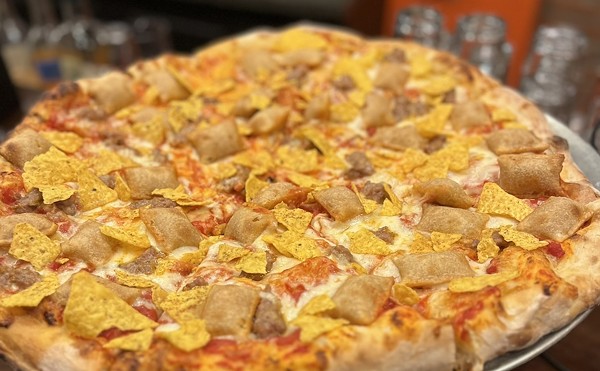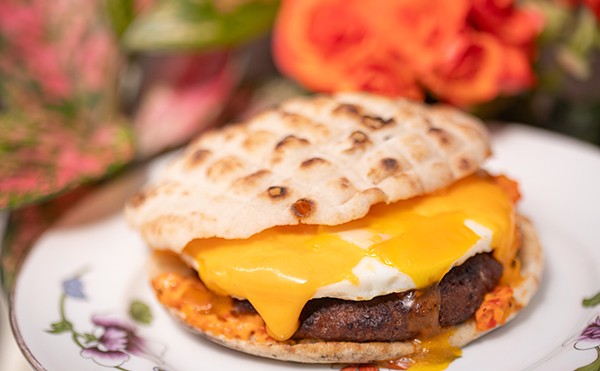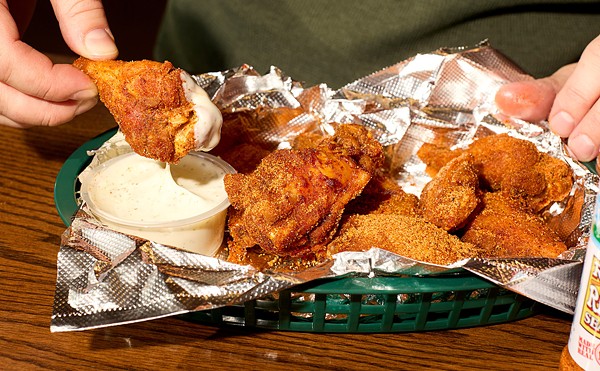That's a trick question, of course.
No such animal exists, except as the most general of categories. There are Indian foods, a range of cuisines nearly as vast as the subcontinent itself. The cuisine of the north, descended from the Moghul Empire to just about every Indian restaurant in the world; the coconut-imbued dishes of the south. Elegant biryani from Hyderabad, where north and south meet; fiery vindaloo from tiny Goa, the former Portuguese colony on the east coast.
Still, now more than ever, I find myself asking: What is Indian food?
I blame the nihari at Indian Food.
What is Indian Food? That's much easier to answer. A restaurant, now six years old, it occupies a modest, somewhat dim storefront between the Jamaican restaurant De Palm Tree and Pratzel's Bakery in Jeffrey Plaza, the shopping center just east of where Olive Boulevard intersects with Interstate 170.
If you're like me, you notice Indian Food's sign whenever you drive — or, really, given the roadwork there, creep — past Jeffrey Plaza and wonder how much of this incredibly broad cuisine a place so unassuming can claim.
Look more closely at the sign, though, and you'll see that Indian Food offers Pakistani and Indian cuisine. Indian Food is a family business — owner Zahid Khan and his elder son, Zack, handle the front of the house; his wife, Shaheena, and daughter, Nazish, tend to the kitchen — and the Khans are originally from Karachi, Pakistan.
Which proves my point, I guess. "Indian food," as a category, even extends beyond modern political borders.
Take the nihari. The version with beef is the only "chef's recommendation" on Indian Food's menu, and it's a doozy. I can't urge you strongly enough to try the dish at least once in your life.
It doesn't look extraordinary when it's delivered to your table. A dark stew, chopped cilantro scattered across its surface, chunks of beef shank bobbing ever so slightly. The aroma is pungent — it can't possibly remind you of Vietnamese pho, can it? But before your first bite, young Zack Khan would like you to notice something.
He points to a small, pale object barely breaking the surface of the nihari. "See that?" You nod. "And that? And that? Limes. Some people like to squeeze them in the dish. That really sharpens the flavor."
You fish out the slivers of lime, each smaller than a penny, and do as he says. Spoon some of the nihari over rice and scoop it up with chapati, an unleavened roti (bread), circular like naan but more like a grilled tortilla in texture.
First there's an explosion of lime, cilantro and — more than anything else — ginger. A breathtakingly sharp combination of flavors. Then the beef, a tough cut stewed tender, full of savor, with the buttery note of ghee. Then, on the finish, the subtle blending of spices that is the hallmark of most Indian dishes, regardless of their origin — a hint of toasted cumin and cardamom that lingers just long enough to spice the next burst of ginger, lime and cilantro.
Nihari is unlike anything I've tasted in an Indian restaurant. With good reason. It's a specialty of Pakistan, served in the famous nihari houses of Karachi and Lahore. But here, too, the borders blur. Where did nihari originate? After all, Pakistan, as an independent nation, is only 60 years old. Some argue nihari started with Delhi's Muslim community. Does that make it an Indian dish? An Indian-Pakistani dish? Indian-Muslim? How does nihari differ from Karachi to Lahore to Delhi to St. Louis?
What is Indian food?
There's no easy answer, but I'll chase these questions forever if it means I can keep eating nihari at Indian Food.
Of course, Indian Food offers much more than nihari. In fact, a casual fan of Indian cuisine will recognize most dishes on the menu: samosas and saag paneer, tandoori chicken and naan.
That saag paneer is fantastic, by the way, the spinach so creamy it seems to dissolve around the cubes of homemade cheese. I also loved the lamb biryani. The serving of fragrant, golden basmati rice was generous enough for two people. The lamb brought a welcome, though not overpowering, depth of flavor to the dish, but the rice was the centerpiece here. I liked the lamb curry, too. It didn't slap you with that strong-but-simplistic flavor of generic curry, but instead snuck up, gradually warming.
As at most Indian restaurants, there are numerous vegetarian options here: the saag paneer, biryani with chickpeas or potatoes and peas. There are lentil dishes and several dishes with vegetables. I tried a few of these during a Sunday lunch buffet, impressed how clearly the flavors of potato and cauliflower held their own against the mild curries, a testament to a cuisine that knows how to cook vegetables.
I also tried tandoori chicken at the buffet. This is never the best time to try this dish. I want it sizzling, with a squeeze of lemon. But the meat was very tender, with a strong charbroiled flavor.
Maybe the biggest hit at the lunch buffet was a small bit of orange chutney. This was served room temperature but had a little spice to it. It was enjoyable on its own, but then Zack Khan pointed out that it was meant to pair with a bread he'd brought, light and almost sweet. The match was exquisite. When we returned a few days later, Khan remembered us and offered to try to find more of that chutney. No such luck, but we didn't mind.
The service is incredibly personable. Zahid and Zack Khan will be your servers, and while you may not receive everything as quickly as you're accustomed, and while you may sometimes receive your naan or chapati a few minutes after your entrées arrive — remember, there are only two cooks back there — the food is worth the wait.
The room is spare, though in the evening, a projection TV set broadcasts Indian music videos and movie trailers, and music videos that double as movie trailers. Or maybe movie dance sequences shot to look an awful lot like music videos.
It's hard to tell sometimes.
Along one wall are photographs of Pakistan, panoramic scenes blown up to poster size. From a distance, one seemed to feature ice-skating horses against a mountain backdrop. I took a closer look: the world's highest-elevated polo field.
Zack Khan must have noticed my interest. "You see those pictures?" he asked.
"We were just smiling about the polo field."
"All of it destroyed," he told us matter-of-factly. "By the earthquake a few years ago."
Clearly, I still have a lot to learn. About Indian food and Indian Food. I look forward to learning, dish by dish.
Have a suggestion for a restaurant the Riverfront Times should review? E-mail [email protected].





